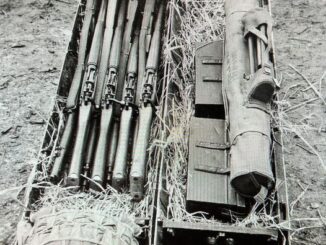The Sterling submachine gun is one of the better submachine guns ever built – a lot of throught and engineering work went into its design. It is light, compact, ergonomic, very durable and reliable, and uses one of the best magazines ever made for submachine guns. It may be a gun overlooked by a lot of people, but it is a great piece – and whether you have never heard of it before or own one yourself, James Edmiston’s book The Sterling Years will entertain and educate you.
Edmiston was a British entrepreneur who purchased the Sterling company and factory in 1971 and owned it until the early 80s. During that time it produced standard and suppressed Sterling SMGs, AR-180 rifles in partnership with Armalite, and a number of other smaller product lines. Edmiston’s account of the time offers an interesting perspective on arms manufacture from a point of view not often heard. Among pother things you’ll find within its pages are:
- How H&K turned the British SAS into an active sales force
- Why you can privately own a jet fighter company in France but not a gun factory
- An Englishman’s experience staying with a Wyoming LDS family
- Why you shouldn’t underestimate the arms industry in Singapore
- Seedy details of the SA-80 development program
More a memoir than a formal history of the company, The Sterling Years provides great anecdotes from farflung sales expeditions (and right at home in the UK), and deserves a place on the bookshelf of anyone who wants a more complete understanding of where their firearms come from.
The 2011 paperback edition is in print and just a click away at Amazon:



Having worked on sterling SMG’s, they were very old fashioned, their manufacture was out dated, with brazing, solid pins, and parts machined from solid that could have been stamped. They typified the downfall of British manufacturing that could’nt modernise itself.
No argument on any point there – but none of those elements make for an inferior gun. Expensive, yes, but you don’t have to be at the bottom of the price scale to be successful.
Hi Ian,
Thanks for this review of what must be a fascinating insight into the inner workings of the gun manufacturing business and the all the politics that go with. I am especially interested in Mr. Edmiston personal views on the Singaporean arms industry.
R.
@ Rich: Having worked “with” the Sterling and also “with” the HK MP5 variants I have to say that not only I but everyone I “worked” with mourned the replacement of the Sterling by an inferior CQ weapon.
You say: They typified the downfall of British manufacturing that could’nt modernise itself.
(not my punctuation by the way)
So how is US manufacturing doing these days? It seems that most of it is long gone from US shores: made in China or Taiwan is stamped on most manufactured items that I see in the USA today ergo it would seem that US manufacturing “couldn’t modernize itself” either. Or is the reason (as it was for the Sterling) more a question of national and international politics, cost-cutting and short-sighted decision making by the respective governments involved.
I respectfully submit that it was the latter.
To quote John Ruskin: “There is hardly anything in the world that some man cannot make a little worse and sell a little cheaper, and the people who consider price only are this man’s lawful prey.”
We have plenty of arms manufacturing capacity still in the US, although our grass-root innovation has been seriously hampered by the NFA and GCA.
Hi, I was wondering if anyone can tell me if this book includes any information on the AR-180 or AR-18. Ideally I’m after info on the variants that Sterling produced or info on Phil Hart (any biographical info or his work on othe Sterlings would still be of interest).
I have several AR-180’s including an AR-180PSC and (after an 8 year search) I was lucky enough to track down the ONLY Sterling AR-180SW ever produced (The SW was a one off prototype) so I’d love ANY info on it, Phil Hart or Sterling.
Any other books I should be looking for?
Thanks
Ian